This is a guest blog post by Val Geisler, who you may know from the ConvertKit Blog. Val shares her insights on building anticipation around your course launch with a tactful email strategy.
We all have that friend: the early adopter. They stand in line outside of the Apple store at 4am every time there’s a new iPhone out. Or they set calendar reminders for the day the tickets go on sale for that new conference with all the hype around it. Or they regularly support Kickstarters and GoFundMe campaigns just so they can be the first. They can say “I was there when….” Maybe that friend is actually you.

Since I know you want your course to launch like the latest iPhone, you’re going to need anticipation to make it happen.
In this post, I’ll walk through why building anticipation is important, how to do it and show you exactly how to set up and write our email sequences.
You ready?
Why You Should Build Anticipation with Emails
While you’re slaving away in your dungeon off creating your gorgeous course, your audience is waiting to hear from you. The difference between a sold out course and one that falls short is more often than not, lack of anticipation from the audience.
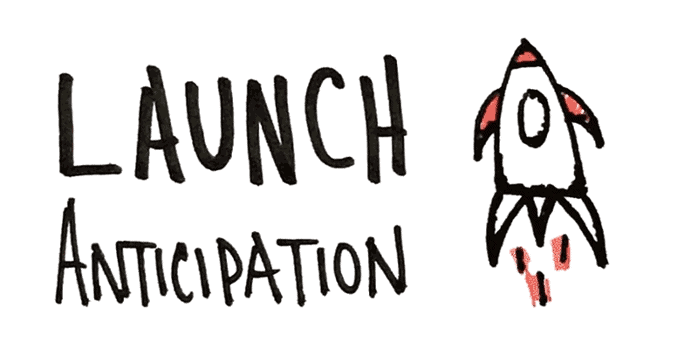
Most course launches take time and effort to execute them well. While many course creators do the initial step of collecting email address for the months before the course comes out, that step is meaningless if those subscribers never hear from you until it’s time to pitch them something.
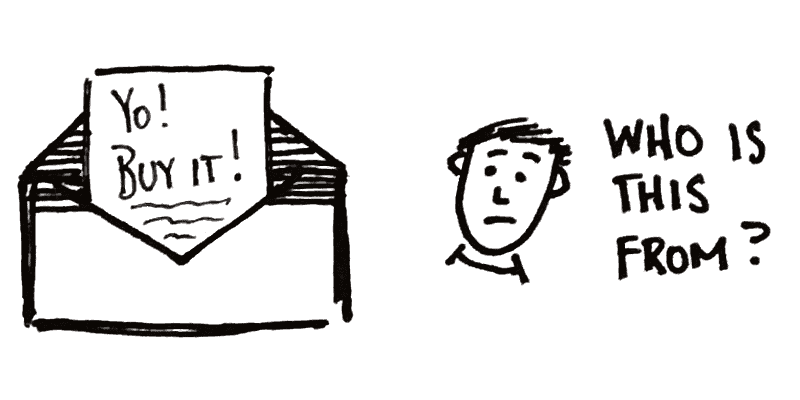
The world moves a million miles a second (approximately) and those new fans who just subscribed to your list they aren’t going to have a clue who you are or how you got their email address if they don’t hear from you for weeks.

You know that guy who drives 10 miles under the speed limit on the freeway and how you’re muttering to yourself about how that’s illegal and he could really cause an accident doing that? Well you’re that guy in the world of email if you aren’t staying in touch regularly with your audience.
1. Use email to share sneak peeks behind the building of the course or teach pieces of your favorite lessons that they’ll find in more detail once they’re inside.
2. Grab their attention early and build anticipation often and you’ll have an email list full of people who are ready to buy once you open the virtual doors.
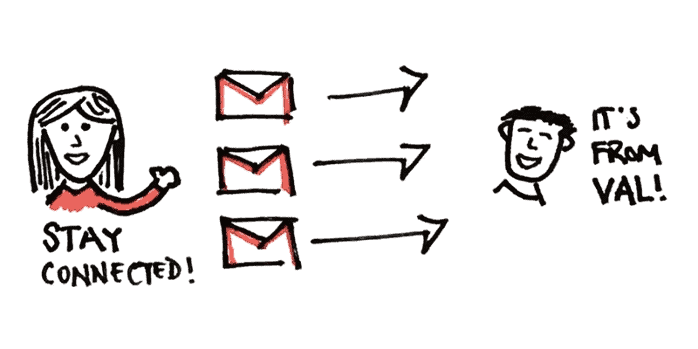
At ConvertKit, we talk a lot about how building an audience you own is crucial. We talk about how even a popular post won’t help you if you don’t have a system to capture that traffic. Social media and RSS have really poor engagement, so we need a platform where almost every interaction gets attention.
Can you guess what that is?
Yep, email.
Every week someone writes an article on how email is dead or dying and needs to be replaced. The social media gurus will only talk about how to increase your Twitter and Facebook followers. What they won’t say is that engagement is terribly low on those platforms.
On Facebook, organic reach allows less than 20% of your fans to see a single post, and even then there is no guarantee they will actually read it.
With email it’s not hard to get a 50% or higher open rate. This means that over half of the people who receive it actually interact with your content. Take a look at a few recent broadcasts sent via ConvertKit:




Email matters. Got it?
So how, then, do you drive a sense of anticipation in your audience through email for your next course launch?
Why You Should Share Your Best Content
Since you’re here on Teachable’s blog, you clearly know that teaching is a foundation for a thriving business. “Teach Everything You Know” is a core principle at ConvertKit. Perhaps you’ve adopted it too. But you always wonder in the back of your mind “Won’t teaching everything negate the product itself?”
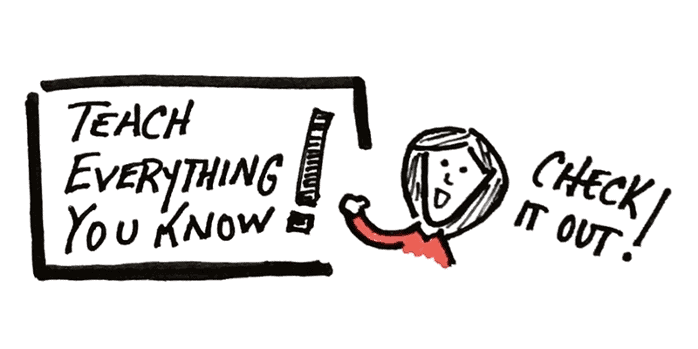
Not according to the chefs of the world.In most industries trade secrets are kept, well, secret. Locked down behind firewalls and protected by non-disclosure agreements. Quite the opposite with chefs. They take their secrets, what we know as recipes, and write them down in a way that is easy to follow.
These recipes get bundled into books and sold to everyone for just $15 or $20. Imagine that, the trade secrets of your business, your competitive advantage, made available for the entire world.
But chefs don’t stop there. They go a step further and get cameras to record every step of the process while they narrate, providing every detail that you may have missed reading their recipes. Then they put those videos online and on television – there are several cable networks devoted to shows just like this.
Aren’t they scared another restaurant will open up across the street, steal their best recipes, and put them out of business?
Of course not.
By teaching these chefs build credibility and an audience. Think of every chef you can name. My guess is that most of those who come to mind have cookbooks and TV shows where they give out every secret recipe. Doing that makes their restaurants book out months in advance.
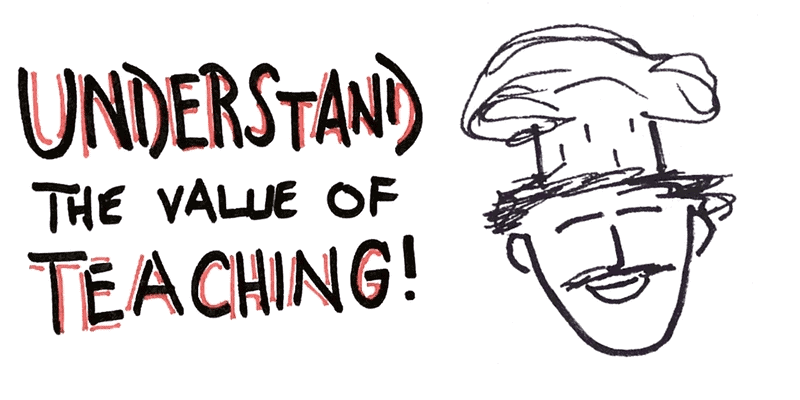
The reputation and anticipation they build just helps sell their product even more.
Are you convinced that anticipation matters? Good. Now for some great news from ConvertKit founder, Nathan Barry:
“With my previous launches I had built up to anticipation over a matter of weeks, not months or years. Each time I talked about it the likely buyers got more and more excited. Then I give a clear date for when the product will launch and be available for purchase.
The day before launch I send out a detailed email providing every bit of information my subscribers need in order to make a purchase. This email covers the benefits of the product, pricing information, and even answers frequently asked questions (that actually haven’t been asked yet).
The one thing the email doesn’t include is a link to buy the product.
Instead I tell them exactly when the product will be available (8:00 AM Eastern tomorrow) and to expect another email from me at that time.”
How to Setup Your Email Sequence
Since the timing and details inside these launch emails are crucial to both teaching about your product and also building anticipation, we give you the framework right inside ConvertKit every time you go to create a new email sequence. Like this:

Now to get down to the nitty gritty (since that’s what you really want, right?), let’s dive in deeper for some clear email strategy for your course.
Start Building Your Email List
For each new launch, it’s best to maintain one email list. All the subscribers—no matter where they signed up—go onto that one list with a tag that marks them as someone who has shown interest in, or even purchased, that product or course (this is called a subscriber-center list and it’s what we do at ConvertKit).
The first place to start getting email subscribers on your list is from your initial course landing page. For advice on creating this page, check out How to Build a Powerful Sales Page with Joanna Wiebe.
With Teachable, it’s easy to build a pre-launch interest list and start gathering email addresses right away. Here’s an article from Teachable on how to do it.
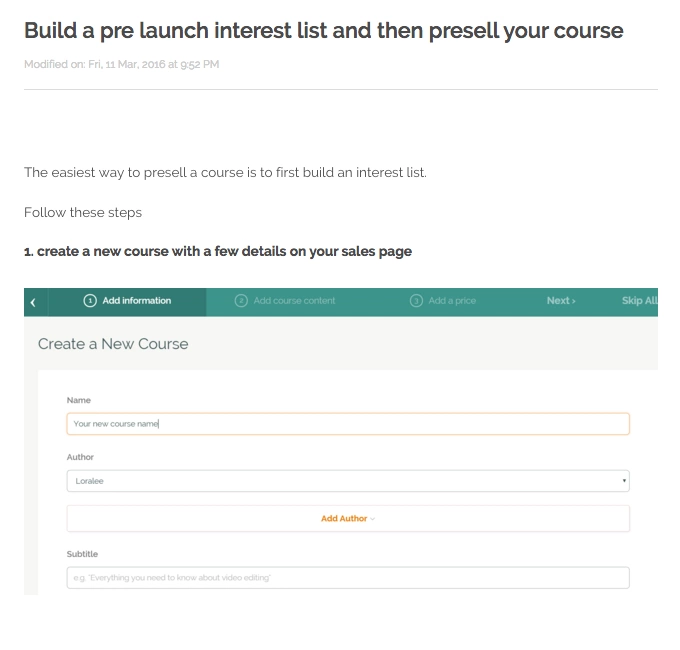
Give a 2 line synopsis of what’s said in that post.
After your launch you can add those course-specific subscribers into your “all subscribers” or “general list” tag so you can keep in touch with them long term.
Get Sign-Ups
Now you need two sign up forms that each point to that same list. The first sign up form is what you connect to your Teachable pre-launch interest list page, the second will go at the end of each of your educational blog posts.
Pro tip: A great place to re-use your email content is on your blog. Change up the wording slightly so it reads like a blog post and not like an email and make use of that valuable real estate at the bottom of the post with an email opt in form.
Using ConvertKit makes it really easy to setup multiple forms and track views and conversion statistics separately for each one. For example a good landing page should convert qualified visitors to an email subscriber at a rate between 15% and 40%. Whereas a form at the bottom of a blog post typically converts at 3% to 8%.

A note on conversion rates
A bit off topic, but we have to stop here to make a quick note about conversion rates. Most people think that a page or form converts at a certain rate. Meaning if you take any traffic source, point it to a specific page, then the x% of purchasers or subscribers will come out the other side of the Internet machine.
That’s simply not true. The details of the page have far less to do with the total conversion rate than the quality of each visitor. Conversion rates often start high (as your most dedicated fans hit the page), then drop as you promote the page to a larger audience.
If you hear of a radically high conversion rate, always ask about where the traffic came from and how pre-qualified it was. That’s actually why email is so insanely effective compared to other sources: you have time to pre-qualify and pre-sell all the traffic.
Write Your Anticipation Emails
Instead of writing a dozen or more sales-centered emails to your new list of adoring fans, focus on writing three to four emails educating your audience on a topic you’re passionate about (hopefully it’s related to that course you’re selling at the end).
This could look like some course content you decided to pull from the final product, maybe it’s the behind-the-scenes of how you use what you’re teaching in your own business.
Since many course creators teach what they wish they had known when they started out, dig back into your thought archives and recall what mattered most to you back then.
Give them what they need now and provide as much value as possible – you won’t be taking anything away from your course content by doing this, promise. Mariah Coz and Tara Gentile do this all the time (and have the massive audiences and wildly successful businesses to prove our point here).
Example 1: Mariah Coz

Example 2: Tara Gentile

Just be sure your educational emails contain the following:
- a quick update on the progress of the course
- a request to share the email (or the blog post where you’ve already setup this email content on your blog)
- value – some people would even say to write something so valuable you almost want to charge for it. That’s when you know you’ve got something good.
Pro tip – Use these same emails and publish them on your blog (taking out the email formatting, of course) and then add your post-blog opt in form at the bottom. Add in a call to action at the end of your post inviting your readers to join your email list. Adding the call to action inside your blog post can increase conversions 3-4% on that form.
Write Your Launch Emails
Once it’s launch day, the hard work is done. Send a simple email (and post it on your blog) saying that the product is ready and pointing them to where they can buy it. Keep this one simple and super clear.
Here’s one from Matthew Kimberley:
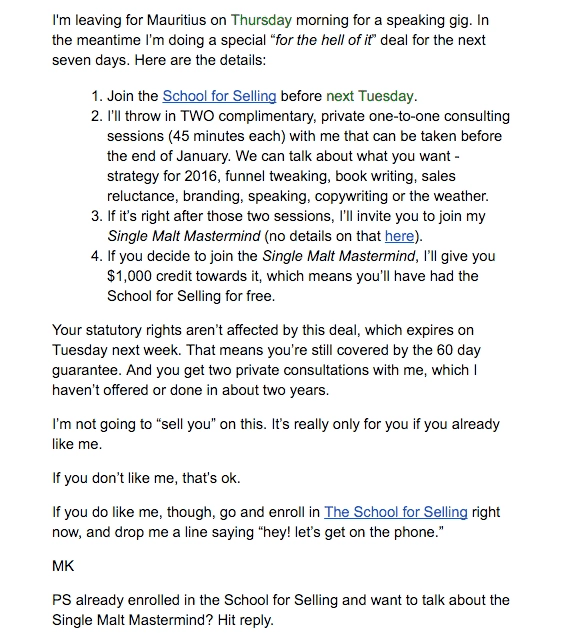
You’ve built up anticipation for weeks or even months and your list is primed to hear about it. When you get lazy and cut straight to the sales pitch that your launch starts to hit the danger zone.
So your emails matter (and can do double duty) in a course launch but there’s one more tool you can use to get even more sales through those emails in the days after you’ve officially launched and before your doors close.
Offer a Limited-Time Discount
Have you ever been out shopping and been on the fence whether or not to buy that shirt? Often just knowing that it is 20% off today, and won’t be tomorrow, is enough to push you over to buying now. Urgency is a really common marketing technique because it works so well.
For marketers it is very dangerous if a customer thinks “Oh, I’ll buy that later.” Because chances are if you don’t buy it right now, when your interest is the highest, you’ll forget or lose interest.
There are four easy ways that you can create urgency in your launch emails to get your on-the-fence customers to purchase now:
1. Have sale or promotional pricing ending soon, like Melyssa Griffin does:
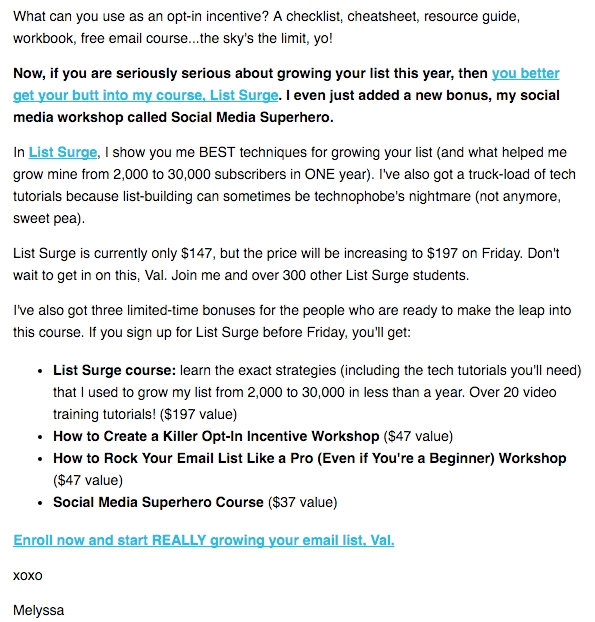
2. Make the product available for a limited amount of time, like this from Ramit Sethi:
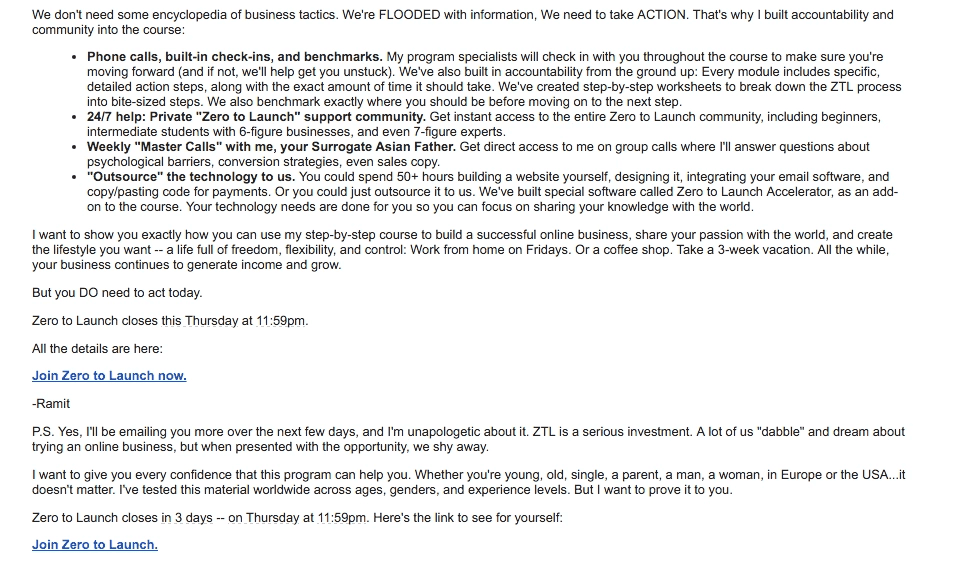
3. Provide an additional bonus only available to the first x number of customers, like this PS from Racheal Cook:

4. Limit the quantity available for sale, like Claire Pelletreau did with a recent beta program:

And all of this can and should be communicated via email. The timing will vary depending on how long your cart is open, if your course is evergreen, and a few other factors but these urgency based emails will all come after that initial launch email.
Should you do all 4? Absolutely not. But picking one or two strategies that will resonate with your audience can produce massive results. With careful planning, your urgency emails can skyrocket sales up front and then create a ripple effect for the rest of your launch.
It all starts with your course
We want your course launch to be successful and this guide is a great outline to have it all line up. With the powerful tools Teachable provides to build your course and a clear game plan in your email marketing (check out ConvertKit, btw), you’ll be ready to roll for your next launch and beyond.
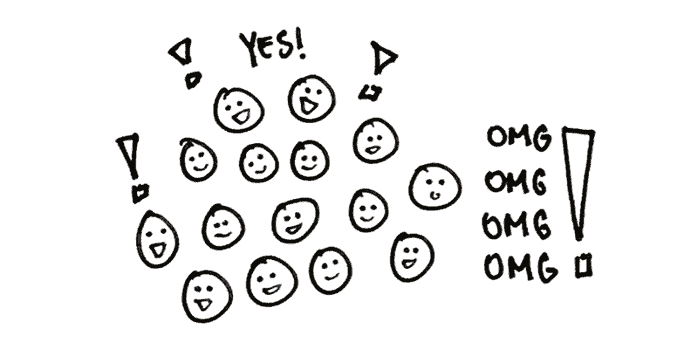
Join more than 150,000 creators who use Teachable to make a real impact and earn a real income.



%201%20(1)%20(1).png)

.png)
.png)
.png)
